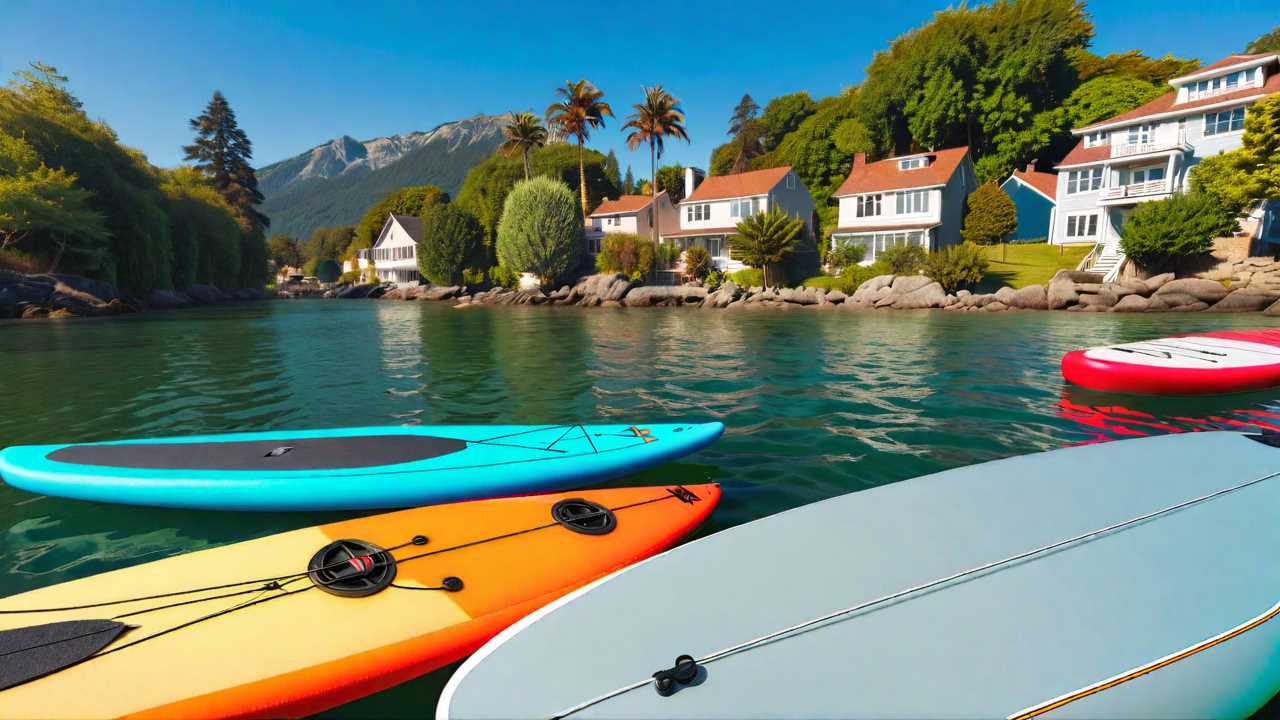
When selecting the ideal paddleboard to suit your needs, it's important to consider various factors like your preferred paddling style, the board's dimensions and weight capacity, and the materials used in its construction. Understanding how these elements align with your skill level can significantly impact your overall experience on the water. As you navigate through the vast array of paddleboard options available, the key lies in finding the perfect balance that caters to your specific requirements. So, let's explore the intricate world of paddleboard selection and uncover the secrets to making an informed decision that will enhance your paddleboarding adventures to new heights.
Understanding Different Paddleboard Types
When choosing the right paddleboard, understanding the different types available is essential for selecting the perfect fit for your needs and preferences. There are various types of paddleboards designed for specific activities such as surfing, touring, yoga, racing, and all-around use.
Surfing paddleboards are typically shorter and have a more pronounced rocker to navigate waves effectively.
Touring paddleboards are longer and narrower, providing better tracking and speed for long-distance paddling.
Yoga paddleboards are wide and stable, with a soft deck pad for practicing yoga poses on the water.
Racing paddleboards are sleek and streamlined for maximum speed in competitions.
All-around paddleboards are versatile options suitable for various activities, offering a good balance of stability, maneuverability, and performance. By understanding these different types of paddleboards, you can make an informed decision based on your intended use and skill level, ensuring an enjoyable and fulfilling paddleboarding experience.
Factors to Consider Before Buying
Consider these key factors before purchasing a paddleboard to guarantee it aligns with your specific needs and preferences.
First, think about the type of paddling you plan to do. For calm waters and recreational use, a wider, more stable board may be ideal, whereas if you aim for speed or maneuverability in choppy conditions, a narrower design could be better.
Next, consider the volume and weight capacity of the paddleboard. Make sure it can support your weight along with any additional gear you might bring along.
Additionally, think about the board's length and width. Longer boards track better and are faster, while shorter boards are more maneuverable.
The board's construction material is also important; inflatable boards are convenient for storage and transport, while solid boards provide better performance.
Matching Paddleboard to Your Skill Level
Choosing a paddleboard that aligns with your skill level is essential to guarantee a safe and enjoyable paddling experience. If you're a beginner, opt for a wider, more stable board. These boards are easier to balance on, making learning how to stand and paddle much simpler. Look for boards with a volume that can support your weight comfortably.
As you progress to an intermediate level, consider a slightly narrower board for increased maneuverability and speed in the water. Intermediate boards offer a good balance between stability and performance, allowing you to refine your skills without feeling too restricted.
For advanced paddlers, narrower and longer boards are ideal for speed and agility. These boards are more challenging to balance on but offer greater control and efficiency once you've mastered the technique. Advanced boards are designed for experienced paddlers looking to push their limits and tackle more demanding conditions.
Always be honest with yourself about your skill level to choose a paddleboard that will help you progress while keeping you safe on the water.
Additional Accessories and Maintenance Tips
To improve your paddleboarding experience and guarantee the longevity of your equipment, it's essential to invest in the right accessories and follow proper maintenance tips. Key accessories include a high-quality paddle that suits your height, a comfortable and secure leash to keep you connected to your board, a personal flotation device for safety, and a waterproof bag to protect your essentials.
Additionally, consider investing in a board bag for transportation and storage, a repair kit for minor fixes, and a grip pad for better traction.
Maintenance tips are vital for prolonging the life of your paddleboard. Rinse your board with fresh water after each use to remove salt and debris, store it out of direct sunlight to prevent heat damage, and regularly inspect for any dings or cracks that may need repair.
Keep your paddle clean and dry, and store all accessories properly to prevent damage. By investing in the right accessories and following maintenance tips diligently, you can improve your paddleboarding experience and ensure your equipment lasts for many adventures to come.
Frequently Asked Questions
Can I Use a Paddleboard for Yoga and Fitness Activities?
Yes, you can absolutely use a paddleboard for yoga and fitness activities. Paddleboards designed for yoga have wider, more stable shapes. Look for ones with non-slip surfaces and ample space for your routines. Enjoy your workouts on the water!
How Do I Transport a Paddleboard if I Don't Have a Car?
When you lack wheels, consider a paddleboard cart. These handy gadgets are like the BFF of your board, effortlessly wheeling it around. Compact, foldable, and a lifesaver for getting your board to the water.
Are There Weight Limits for Paddleboards?
Yes, weight limits for paddleboards vary depending on their design and materials. It's important to check the manufacturer's guidelines to make sure you don't exceed the limit, as overloading can affect performance and safety.
Can Paddleboards Be Used in Saltwater and Freshwater?
Yes, paddleboards can be used in both saltwater and freshwater. Just make sure you rinse your board thoroughly after saltwater use to prevent corrosion. Always check manufacturer guidelines for specific care instructions.
What Is the Best Way to Store a Paddleboard When Not in Use?
When not in use, store your paddleboard like a precious treasure in a dry, shaded spot. Keep it away from direct sunlight and harsh elements. Use a board bag or cover for added protection.
 SportsHollywoodLifestyleFashionHome & GardenTrendsPrivacy PolicyTerms And Conditions
SportsHollywoodLifestyleFashionHome & GardenTrendsPrivacy PolicyTerms And Conditions
